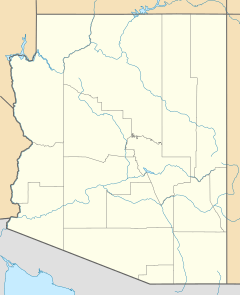Murderer's Grave Station facts for kids
Quick facts for kids
Murderer's Grave Station
|
|
|---|---|
|
Locale
|
|
| Kinyon Station, Kenyon Station | |
| Country | United States |
| State | Arizona |
| County | Maricopa |
| Elevation | 380 ft (120 m) |
| Time zone | UTC-7 (MST (no DST)) |
Murderer's Grave Station, also known as Kinyon Station and Kenyon Station, was a very old and important stop for stagecoaches. It was part of the famous Butterfield Overland Mail route. This historic spot was located in Arizona, right along the Gila River.
Stagecoaches were like old-time buses. They carried people, mail, and goods across the country before trains and cars existed. Stops like Murderer's Grave Station were vital. They offered fresh horses, food, and a place for travelers to rest.
Contents
History of the Station
This area has a long and interesting past. It was first known by a different name given by early explorers.
Early Native American Village
Long before it became a stagecoach station, the site was a Native American village. In 1774, a Spanish priest named Father Francisco Garcés visited the area. He named the village Rancheria de San Diego.
The Name "Murderer's Grave"
In the 1850s, during the California Gold Rush, many people traveled through this area. They were heading to California hoping to find gold. The site got the name "Murderer's Grave" from an event that happened there. It involved travelers on the Southern Emigrant Trail.
Becoming Kinyon Station
In 1858, the site was renamed "Kinyon Station." This new name honored Marcus L. Kinyon. He was the station agent for the Butterfield Overland Mail. A station agent was like the manager of the stagecoach stop.
Changing to Kenyon Station
The name changed again in 1872 to "Kenyon Station." This time, it was named after Charles H. Kenyon. He was a superintendent for a stage line that ran from Tucson to Yuma. He managed the operations from 1872 to 1879.
Location Details
The site of Murderer's Grave, or Kenyon Station, is in Maricopa County, Arizona. It sits at an elevation of 380 feet (about 116 meters) above sea level. You can find its exact location on detailed maps of the Horn, AZ area. Today, it is near the Painted Rock Reservoir.



